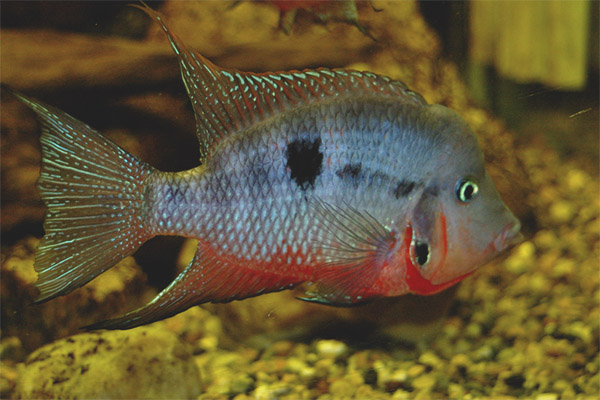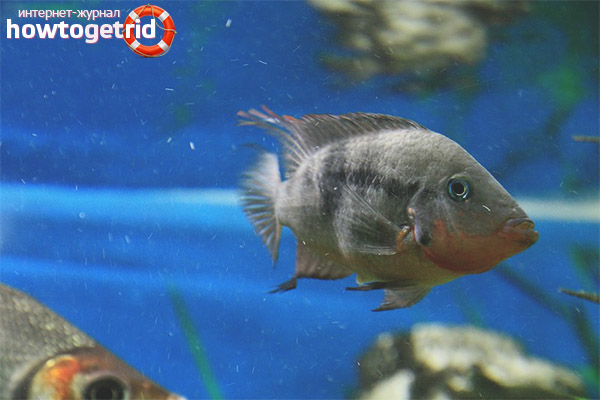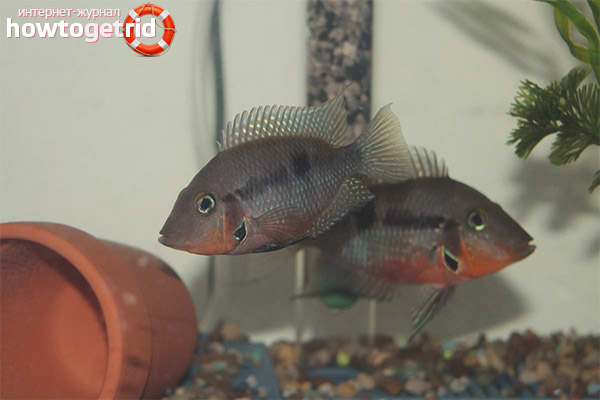The content of the article
Cykhlazoma Meek has the Latin name Thorichthys meeki, and is one of the most sought-after representatives of cichlids. These fish are in great demand due to the many advantages. They have an attractive appearance - the color of the fish is bright red. In addition, they get along well with other fish. In the care of representatives of this type is not very demanding.
If we compare them with other cichlids released from Central America, the fish are small. In length, they grow to 17 cm. They have a graceful and slim build. Such a fish can be purchased not only by an experienced aquarist, but also by a beginner amateur. As already mentioned, due to the unpretentiousness of Tsihlazoma Meeki, it is quite simple to care for her. In addition, it does not pose a danger to other individuals, and can live with them in another aquarium.But it is desirable to settle the representatives of this species with the same large fish or separately from all. In normal times, they do not show any aggression towards their neighbors in the aquarium, but it may well suddenly develop during the spawning period. Tsikhlazoma Meeka drives away other individuals from the territory, especially small ones.
During spawning, the male of this species changes its appearance. He becomes very beautiful. The throat gets a red tint, and the body of the fish darkens. This usually scares the rest of the males, and vice versa - attracts the female.
Habitat in nature
Representatives of the species Tsihlazoma Meek are inhabitants of rivers or canals with slow-flowing waters.They live near the bottom or in the middle layer. In addition, they can be found in ponds. In reservoirs inhabited by meeki, usually sandy or muddy ground. They feed on both plant and animal food. In the reservoirs try to be near overgrown areas.
Description
Representatives of the species have a graceful body. Their muzzle is pointed. The fins of the fish are large, have pointed ends. In nature, representatives of the species Tsihlazoma Meek can grow up to 17 cm. At the same aquarium content, they usually grow to smaller sizes. The average length of males can reach about 12 cm. At the same time females are usually 2 cm shorter. Such a fish can live 10-12 years.
The main feature of the exterior is the red color of the throat and gills. Part of the abdomen is also colored red. The rest of the body has a steel color. It has vertically arranged dark spots. Fishes that live in different areas, may differ slightly in color.
Content issues
It is possible to acquire such fish even for those who have practically no experience in maintaining an aquarium, because Tsikhlazom Meek is unpretentious.It can adapt to different conditions. This is due to the fact that the fish of this species live in a variety of waters, and have learned to adapt in order to survive. But when caring for these fish, it is still necessary to follow the basic rules.
Another advantage is the omnivorous nature of these fish. They fit almost any feed. In addition, with other inhabitants of the aquarium she gets on quite peacefully.
Feeding
Cychlasma Meek can eat any kind of feed. They are suitable and alive, and artificial, and frozen. To maintain the health of these fish in good condition, it is desirable that their food was diverse. Therefore, they should be given alternately each of the species listed above. The main diet can be special feed for cichlids. They must be of the highest quality. They contain the necessary components to keep Tsikhlasoma Meek healthy. The supplement of the diet can be a live feed. But the bloodworm should be given only occasionally, so as not to provoke inflammation of the gastrointestinal tract.
Content
If you plan to keep only a couple of such fish, it will be enough to have an aquarium of 150 liters. If there are more, you need to purchase a minimum two hundred-liter aquarium.Representatives of this species, like other cichlids, need very clean water. The course must be moderate. It is created by an external filter. In addition, you should periodically change the water.
Tsikhlazoma Meeka loves to dig in the ground. Therefore, for these purposes it is recommended to use sand. In it, the fish will be convenient to build a nest. When arranging an aquarium for meeki, experts advise installing more decor that the fish could use as a shelter. These can be pots, caves, pebbles, etc., because meeki like to hide in them.
If you want to plant in an aquarium plants, it is better to install them there in pots. Otherwise, the fish may dig them. From plants should choose large and tough. For example, echinodorus and anubias.
Representatives of the species, although unpretentious to the characteristics of the water, will still feel better at 24-26 degrees. If you observe the conditions of detention, the fish will live for a long time.
Compatibility
Cychlasma Meek can coexist with other fish. It is desirable that these were the same large individuals.Aggression of this species is manifested only during the spawning period. Individuals who violate their territory at this time may be harassed. Sometimes Tsikhlazom Meek kills neighbors, whom she considers dangerous. If you are concerned about the safety of individuals adjacent to this cichlid during spawning, it is better to plant them for a while. Cychlasma Meek can live with scalars and Akars. But the astronotus for her is too big and aggressive neighbor.
During spawning, these fish can dig a lot in the ground and move its parts from place to place. Therefore, it is important to monitor the plants planted in an aquarium, or plant them in pots.
Representatives of this species form an established couple, and also very well take care of their offspring. In one aquarium several pairs of such fish can coexist, but the volume should be large. Each fish must have its own place to hide.
Gender Differences
Breeding
The most difficult moment in the reproduction of representatives of this species in the aquarium is the formation of a pair. They are monogamous.Therefore, in order to breed them, you must either buy an already established couple, or grow some young ones so that they decide themselves.
The pair clears the stone, and then the female lays caviar. At one time, Tsikhlazoma Meek lays up to 500 eggs. When the fry hatch, the parents take care of them. Fry hiding in shelters, and the fish protect them until they grow up. A week later, they begin to swim.
Video: aquarium fish tsikhlasoma meeka













To send